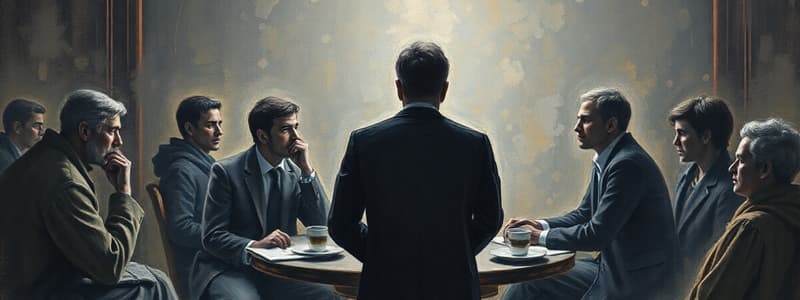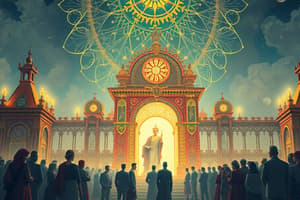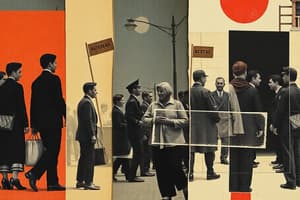Podcast
Questions and Answers
What type of power is exercised due to a person’s position in an organizational hierarchy?
What type of power is exercised due to a person’s position in an organizational hierarchy?
- Coercive power
- Referent power
- Positional (legitimate) power (correct)
- Expert power
Which power base is primarily associated with the ability to provide knowledge and expertise?
Which power base is primarily associated with the ability to provide knowledge and expertise?
- Reward power
- Referent power
- Coercive power
- Expert power (correct)
In a participatory work team, how does the exercise of power typically differ from traditional hierarchical models?
In a participatory work team, how does the exercise of power typically differ from traditional hierarchical models?
- Power is overtly demonstrated and strictly enforced.
- Power is absent and decisions are made randomly.
- Power is based solely on role and authority.
- Power is less centralized and decision-making is more equal. (correct)
What type of power relies on the charisma of the individual exercising influence?
What type of power relies on the charisma of the individual exercising influence?
Which basis of power would generally be used to compel a subordinate to act against their usual behavior?
Which basis of power would generally be used to compel a subordinate to act against their usual behavior?
Understanding power in evolving organizational contexts requires which of the following?
Understanding power in evolving organizational contexts requires which of the following?
What do French and Raven's research findings primarily highlight about power?
What do French and Raven's research findings primarily highlight about power?
What is a characteristic of organizations transitioning to flatter and more collaborative systems?
What is a characteristic of organizations transitioning to flatter and more collaborative systems?
What is the primary function of ideology in the context of power dynamics?
What is the primary function of ideology in the context of power dynamics?
Which movement challenged the narrative of capitalism benefiting everyone?
Which movement challenged the narrative of capitalism benefiting everyone?
How does ideology contribute to the perception of societal contradictions?
How does ideology contribute to the perception of societal contradictions?
What concept describes how dominant groups shape reality to their advantage?
What concept describes how dominant groups shape reality to their advantage?
In Burawoy's study, what mindset did workers adopt that reinforced managerial interests?
In Burawoy's study, what mindset did workers adopt that reinforced managerial interests?
What is a potential negative outcome of excessive organizational identification?
What is a potential negative outcome of excessive organizational identification?
How do critical organizational communication scholars typically analyze organizations?
How do critical organizational communication scholars typically analyze organizations?
What can be considered a consequence of ideology in organizational settings?
What can be considered a consequence of ideology in organizational settings?
What does Anthony Giddens refer to as the capacity to act otherwise?
What does Anthony Giddens refer to as the capacity to act otherwise?
Which model of power emphasizes the prevention of action as a means of exercising power?
Which model of power emphasizes the prevention of action as a means of exercising power?
What factor diminishes the effectiveness of reward power?
What factor diminishes the effectiveness of reward power?
How do Robert Dahl’s views on power differ from those of political elitists?
How do Robert Dahl’s views on power differ from those of political elitists?
What does Steven Lukes argue about the ultimate exercise of power?
What does Steven Lukes argue about the ultimate exercise of power?
How did Marx interpret the relationship between ideology and power?
How did Marx interpret the relationship between ideology and power?
Which of the following best illustrates the concept of 'mobilization of bias'?
Which of the following best illustrates the concept of 'mobilization of bias'?
What does the pluralist view of power emphasize?
What does the pluralist view of power emphasize?
In what way does ideology complicate societal relationships?
In what way does ideology complicate societal relationships?
What is the primary focus of the Three-Dimensional Model of Power introduced by Lukes?
What is the primary focus of the Three-Dimensional Model of Power introduced by Lukes?
How do businesses exert power over individuals according to the Three-Dimensional Model?
How do businesses exert power over individuals according to the Three-Dimensional Model?
What role does 'agency' play in understanding power dynamics?
What role does 'agency' play in understanding power dynamics?
What societal characteristic is emphasized by the U.S. ideology of individualism?
What societal characteristic is emphasized by the U.S. ideology of individualism?
Flashcards
Power in organizations
Power in organizations
Power is a key element in organizational interactions and events, affecting dynamics and relationships.
Political sites
Political sites
Organizations are viewed as arenas where various forces and interests compete and interact.
Overt power
Overt power
Power that is clearly visible and exercised in hierarchical relationships.
Decentralized power
Decentralized power
Signup and view all the flashcards
Five bases of power
Five bases of power
Signup and view all the flashcards
Positional power
Positional power
Signup and view all the flashcards
Referent power
Referent power
Signup and view all the flashcards
Expert power
Expert power
Signup and view all the flashcards
Ideology
Ideology
Signup and view all the flashcards
Hegemony
Hegemony
Signup and view all the flashcards
Occupy Wall Street
Occupy Wall Street
Signup and view all the flashcards
Systemic Inequalities
Systemic Inequalities
Signup and view all the flashcards
Equal Opportunity Myth
Equal Opportunity Myth
Signup and view all the flashcards
Power Dynamics in Organizations
Power Dynamics in Organizations
Signup and view all the flashcards
Organizational Communication
Organizational Communication
Signup and view all the flashcards
Exploitation in Corporate Environments
Exploitation in Corporate Environments
Signup and view all the flashcards
Bases of Power
Bases of Power
Signup and view all the flashcards
Relational Power
Relational Power
Signup and view all the flashcards
Coercive Power
Coercive Power
Signup and view all the flashcards
Reward Power
Reward Power
Signup and view all the flashcards
Dynamic Nature of Power
Dynamic Nature of Power
Signup and view all the flashcards
Agency
Agency
Signup and view all the flashcards
One-Dimensional Model of Power
One-Dimensional Model of Power
Signup and view all the flashcards
Two-Dimensional Model of Power
Two-Dimensional Model of Power
Signup and view all the flashcards
Mobilization of Bias
Mobilization of Bias
Signup and view all the flashcards
Three-Dimensional Model of Power
Three-Dimensional Model of Power
Signup and view all the flashcards
Dominant Ideology
Dominant Ideology
Signup and view all the flashcards
Cultural Context of Power
Cultural Context of Power
Signup and view all the flashcards
Reification
Reification
Signup and view all the flashcards
Conflict in Power
Conflict in Power
Signup and view all the flashcards
Study Notes
Organizational Power and Ideology
-
Power is central to organizational life, influencing even routine activities. It operates as a political force, with different actors vying for influence using economic, political, and symbolic resources.
-
Power's visibility varies. It's overt in hierarchical structures like professor-student relationships, where power is clearly exercised. It's less explicit in participatory work teams, where power aims to be more equitable.
-
Understanding power requires nuanced theories, as its nature evolves with organizational change.
Power as Social Influence
-
French and Raven's model identifies five bases of power: positional (legitimate), referent (charisma), expert, reward, and coercive.
-
These power bases often overlap, and power is inherently relational, dependent on interdependence between those in power and subordinates.
-
Power is dynamic and relational, not static. It relies on the value others place on certain resources.
Different Models of Power
-
One-Dimensional Model (Dahl): Power is the ability to influence another to act differently. It requires conflict and focuses on observable outcomes.
-
Two-Dimensional Model (Bachrach & Baratz): Power extends beyond influence. It also involves preventing actions from happening or allowing only certain avenues for expression. It emphasizes the "mobilization of bias".
-
Three-Dimensional Model (Lukes): Power operates in more subtle ways, influencing beliefs, wants, and values, potentially creating conformity through internalizing desires and behaviours aligned with the powerholder. It's not limited to conflict.
Ideology and Power
-
Ideology acts as an interpretive lens, shaping perceptions, values, and possibilities. It is often connected to power, with dominant groups shaping societal ideas.
-
Different ideologies shape power dynamics; for example, the ideology of individualism in the US contrasts with collectivism in some European societies.
-
Ideology shapes communication and identity. Example: the representation of race in colonial Jamaica versus 1950s Britain, showing how discourse creates meaning and power.
-
Ideology obscures power relations by presenting dominant group interests as universal and masking contradictions inherent in society. It also naturalizes relations, seemingly making it appear normal and unchanging.
Organizational Communication and Power
-
Critical organizational communication scholars study power dynamics and resistance within organizations.
-
They examine how organizations shape employee behaviour and how employees resist, using communication practices (stories, rituals, metaphors).
-
Hegemony is a key concept, where dominant groups successfully shape reality. Example: employees' internalizing organizational goals to avoid conflict. This can reinforce hierarchies and exploit workers.
-
These practices limit autonomy and well-being.
Studying That Suits You
Use AI to generate personalized quizzes and flashcards to suit your learning preferences.




